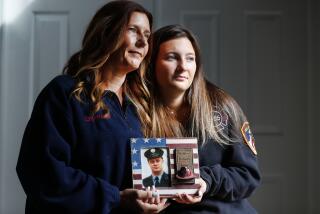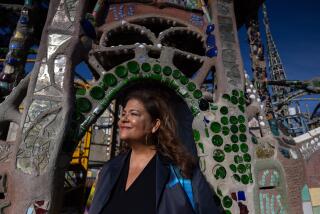A life rebuilt, from the ground up
He’s seen it as a smoldering, horrifying heap of metal.
He’s seen it as a growing frame of steel, rising higher and higher.
And on a recent weekday, as Phil English returned from picking up his paycheck, passing tourists snapping photos of the new building in front of St. Paul’s Chapel, he caught a glimpse of it as it is now -- a massive, sleek tower, 1,776 feet tall. The sight brought tears to his eyes.
Before English started working on the tower in 2007, he was at one of the lowest points of his life. His wife had just died and he was struggling to raise their three children. But then he got a gig at the World Trade Center site, and spent hours breaking up concrete, shoveling debris, emptying garbage bins -- work that distracted him from his grief.
Now, the tower is almost finished, and English has rebuilt his life slowly, step by step, just as he helped rebuild the tower. New York has rebuilt itself too, and the site that has been ground zero for more than a decade will finally take on a new name: One World Trade Center.
The building will be turned over early this year to its new tenants, including Conde Nast and the Port Authority of New York and New Jersey, allowing them to start building out their floors, putting in walls and carpets and desks. Streets that have been closed since Sept. 11, 2001, will finally be open to the public. And finally, Phil English’s life is returning to normal too.
“Without a doubt, this job has gotten me through a lot of tough times,” he said. “It took my mind off of things that are sad.”
English was across the river in Brooklyn, working construction on a building there, when the towers came crashing down. He went up to the roof of the building and saw millions of tiny pieces of paper flying in the sky. That night, he was called into the blocks of burning steel to get to work.
A steel beam had plunged into a building that held Verizon’s corporate headquarters, splitting cables and pipes, destroying computers, halting communications for much of Lower Manhattan. English spent the next 14 hours underground in the darkness, trying to get communications back up.
He wishes he could forget some of the things he experienced in the next eight months as he worked at ground zero: the horn that blew to alert workers a body had been found; the putrefying smell that was impossible to escape; the pervasive fear that it would happen, at any minute, again.
New York slowly started to pull itself together; stakeholders finally agreed on how to rebuild the site, and a new building, Seven World Trade Center, opened in May 2006, replacing a building of the same name that had been destroyed Sept. 11.
But as life in New York slowly returned to normal, English’s world was falling apart. His wife, Phyllis, had gone into the doctor, complaining of pain in her bones, with a horrible premonition that she had cancer. On Jan. 26, 2006, English sat beside her as a doctor uttered the words, “Your worst fears have been realized.”
When she died in April 2007, he was holding her hand. He braced himself for the staggering task of telling his three children that their mother had died.
“I remember being in a dark place for quite some time,” said English, 48, a tall, brawny man with a slight New York accent. “Waking up, not having her next to me.”
Six months later, English’s union, the Laborers International Union of North America Local 79, called. It wanted to assign him to be a shop steward at One World Trade Center and become one of the 26,000 people who would work on the World Trade Center site.
At first, he said no. He wasn’t ready and wanted to spend more time with his kids, then aged 8, 13 and 15. But when they called again, he reconsidered. He needed to make more money to support his family, even if the long hours spent shuttling between home and work -- and making lunches and doing laundry -- left him worrying that he wasn’t spending enough time with the kids.
The work was grueling: emptying bins of building debris, clearing out mounds of concrete, carrying heavy beams. But it was a distraction. There was another helpful but sobering distraction too. Families of the people who had died on Sept. 11 kept coming by. Sometimes they’d be crying, other times they’d thank English and other workers for helping to rebuild what had been destroyed.
English understood their grief. And their shared loss somehow made him stronger.
“It was knowing that other people went through what I went through,” he said. “It was knowing that thousands of people lost their lives, but I was trying to fix it -- build New York back up.”
The Port Authority has taken measures to make sure the new building can’t be brought down so easily. Parts are made of a special reinforced concrete that can withstand pressure of 14,000 pounds per square inch (regular concrete can withstand pressure of 2,000 psi). The rebar is much thicker than that used in most buildings, and the tower has a firefighters elevator, which is waterproof, and a firefighters staircase.
As for English, the rebuilding of his life continues. His own experience and talking to families of Sept. 11 victims have taught him that he needs to be grateful for every minute he spends with his family, even those moments clouded by loss.
“I told my kids, ‘This is something we’ll never get over. The pain will always be there, but every day, the pain will get a little better.’ ”
A year or so ago, five years after his wife’s death, English reconnected with an old friend from his childhood. They started dating, even though she lives in Chicago, and they are now planning to spend the rest of their lives together. They recently returned from a cruise in the Bahamas, his first vacation in years.
It’s not the same as it was, but then again, neither is the building he helped create from the ground up.
He was there, on the roof, in May, when construction workers erected the spire on the top of One World Trade Center, making it the tallest building in the Western Hemisphere. He remembers standing on the roof, peering at the Brooklyn Bridge, which looked like a tiny twig; he remembers seeing the familiar speck of the Statue of Liberty, and feeling that the building was finally once again whole.
--
More to Read
Sign up for Essential California
The most important California stories and recommendations in your inbox every morning.
You may occasionally receive promotional content from the Los Angeles Times.











